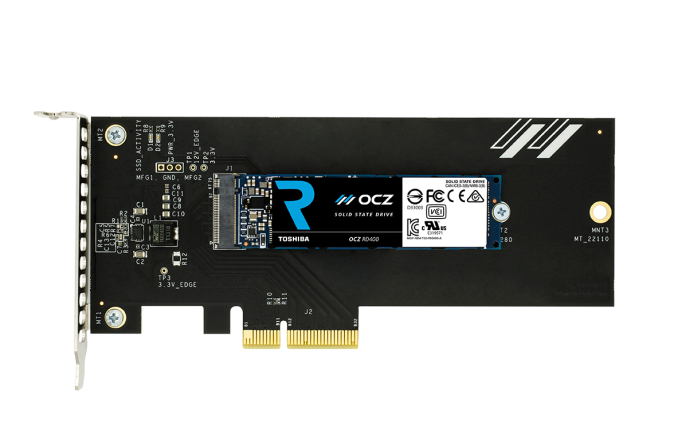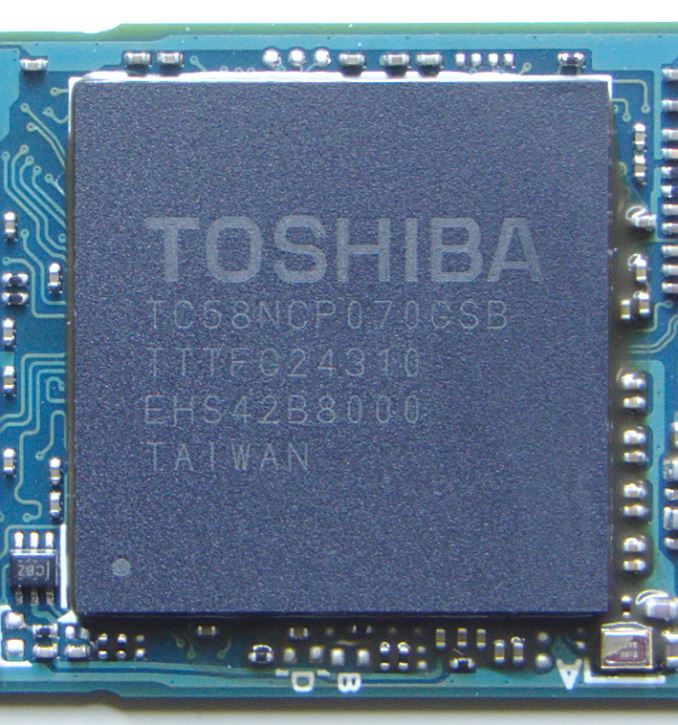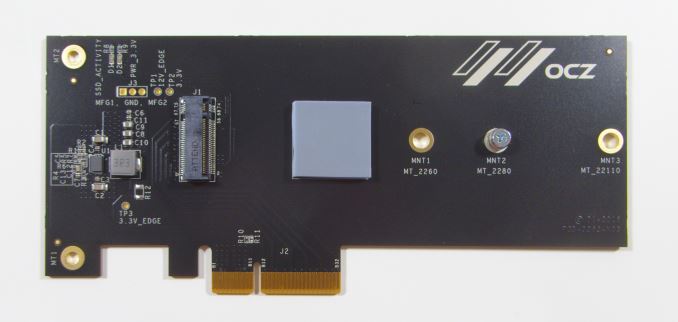The Toshiba OCZ RD400 (256GB, 512GB, 1TB) M.2 PCIe SSD Review
by Billy Tallis on May 25, 2016 8:02 AM EST
Having recently assimilated OCZ and turned it into an enthusiast-oriented consumer brand, Toshiba has released their first M.2 PCIe SSD into the consumer market. Initially previewed by OCZ as the RevoDrive 400, the new OCZ branding scheme shortens it to RD400. This is the first RevoDrive/RD product with a native PCIe SSD controller and the first PCIe 3 SSD from OCZ.
The RD400 uses Toshiba 15nm MLC and a Toshiba-branded controller that we know almost nothing about. Given how the Toshiba-branded controller in the Trion/TR drives seems to be based on the popular third-party Phison S10, we suspect the RD400 may be using a controller that is also based on a third-party design, most likely the Marvell 88SS1093. Our first look at what would become the RD400 showed that it wasn't the OCZ Jet Express controller, and if Toshiba had another entirely in-house controller that could compete at this level they would probably be talking it up more. The Marvell 88SS1093 is an 8-channel 3-core controller with performance specifications that are similar to the RD400.
Whatever the source of the controller, it makes for a far simpler design than the RAID controller and multiple SandForce SSD controllers used in previous RevoDrive SSDs, and it makes the M.2 form factor an option for the first time.
The RD400 shares its hardware with the OEM-only Toshiba XG3 M.2 SSD but the RD400 has different firmware and comes with a custom NVMe driver for Windows that Toshiba says offers better performance than Microsoft's driver. The Toshiba XG3 was announced in August 2015 and we have since encountered it in the Microsoft Surface Pro 4. As a retail product, the OCZ RD400 will not only benefit from the OCZ custom driver, but is also supported by their SSD managment utilities, and is optionally sold with a PCIe x4 to M.2 adapter that includes a thermal pad under the SSD controller. The SKUs that come with the drive pre-installed in the adapter are referred to in some documents as the RD400A, but the M.2 module is the same with or without the adapter.
| Toshiba OCZ RD400(A) Specifications | ||||
| Capacity | 128 GB | 256 GB | 512 GB | 1 TB (1024GB) |
| Controller | Toshiba TC58NCP070GSB | |||
| NAND | Toshiba 15nm MLC | |||
| Sequential Read | 2200 MB/s | 2600 MB/s | 2600 MB/s | 2600 MB/s |
| Sequential Write | 620 MB/s | 1150 MB/s | 1600 MB/s | 1550 MB/s |
| Random Read IOPS | 170k | 210k | 190k | 210k |
| Random Write IOPS | 110k | 140k | 120k | 130k |
| Form Factor | M.2 2280 single-sided | M.2 2280 double-sided | ||
| Protocol | NVMe 1.1b over PCIe 3.1 x4 | |||
| Encryption | None | |||
| Write Endurance | 74 TB | 148 TB | 296 TB | 592 TB |
| Warranty | 5 years | |||
| DWPD Equivalent | 0.31 | 0.31 | 0.31 | 0.31 |
| MSRP (with PCIe adapter) | $129.99 | $189.99 | $329.99 | $759.99 |
| MSRP (M.2 only) | $109.99 | $169.99 | $309.99 | $739.99 |
The PCIe x4 to M.2 adapter adds $20 to the price tag but may be a welcome option for some desktop users. The card itself is generic and bears OCZ branding but has no specific reference to the RD400. Unlike most cheap adapter cards, the RD400's adapter draws power from the PCIe slot's 12V supply and converts it to the 3.3V required by the M.2 drive. All of our power and performance numbers for the RD400 in this review reflect the effect of the bundled adapter's thermal pad and the overhead of the voltage conversion. Thus, this review is of the RD400 in a typical desktop environment rather than in a notebook environment.
Toshiba's overhaul of the OCZ brand has changed the OCZ SSD Guru software into the OCZ SSD Utility and the ShieldPlus Warranty into the Advanced Warranty Program, but the relevant details are the same. Toshiba has also added a new software tool: CLOUT, the Command Line Online Update Tool. Based on an internal testing tool, it offers all the management capabilities of the graphical SSD Utility but from a scriptable command line interface. The ability to perform a secure erase from a script and without having to reboot to Linux is a killer feature for me as a drive reviewer, and the fully automated testing it enabled made the RD400 the first drive to complete our suite of benchmarks in under 24 hours per drive.
The RD400 comes on the market at a time where it's only the second retail M.2 NVMe drive, as while the newer protocol has gained traction, the longer lifecycle of SSD controllers means that it's taking designers a while to update to NVMe. The competition for the RD400 consists primarily of the Samsung 950 Pro - getting Samsung some needed competition in the retail M.2 space - and the Intel SSD 750, the two which have been the two highest performance PCIe SSDs in the consumer market. They're also two of the most expensive current-generation consumer SSDs for sale: the Samsung 950 Pro is selling for 0.62–0.70 $/GB while the Intel SSD 750 is between 0.87 $/GB and 1.00 $/GB. The 256GB and 512GB RD400 models that compete directly against the Samsung 950 Pro have MSRPs below the current 950 Pro prices, which gives Toshiba some room to be competitive even if performance is lower. The 1TB and 128GB models of RD400 on the other hand have less aggressive MSRPs, likely owing to the lack of direct competitors currently on the market.
Finally, looking at the NAND in the RD400, the 15nm MLC used here presents some changes compared to the 20nm MLC in the Intel SSD 750 and the 3D NAND in the Samsung 950 Pro. The most obvious sign is the reduced write endurance rating: the 256GB and 512GB 950 Pro are both rated for 400TB while the RD400 is rated for 148TB or 296TB for the same capacities.
| AnandTech 2015 SSD Test System | |
| CPU | Intel Core i7-4770K running at 3.5GHz (Turbo & EIST enabled, C-states disabled) |
| Motherboard | ASUS Z97 Pro (BIOS 2701) |
| Chipset | Intel Z97 |
| Memory | Corsair Vengeance DDR3-1866 2x8GB (9-10-9-27 2T) |
| Graphics | Intel HD Graphics 4600 |
| Desktop Resolution | 1920 x 1200 |
| OS | Windows 8.1 x64 |
| NVMe Driver | Toshiba OCZ driver version 1.2.126.827 |
- Thanks to Intel for the Core i7-4770K CPU
- Thanks to ASUS for the Z97 Deluxe motherboard
- Thanks to Corsair for the Vengeance 16GB DDR3-1866 DRAM kit, RM750 power supply, Carbide 200R case, and Hydro H60 CPU cooler


















40 Comments
View All Comments
Samus - Wednesday, May 25, 2016 - link
I'm sure a multi billion dollar conglomerate decided to convert the 12v PCIe rail over drawing from the weak 3.3v rail for a reason. Probably something as simple as firmware flashing compatibility. Flashing firmware causes enormous voltage spikes that would easily surpass 10 watts @ 3.3vjjj - Wednesday, May 25, 2016 - link
It's a bit weird to state that the Samsung is the fastest when it loses in write and mixed workloads.Your own benchmark is read heavy but maybe not all readers care most about read perf.
LostWander - Wednesday, May 25, 2016 - link
Read seems to be the most common trait people look for, so if they had to pick one I would agree on that. Kinda odd to give it the title though with no single drive leading in more than a couple benchmarks, it's only "the fastest" in relatively specific categoriesBilly Tallis - Wednesday, May 25, 2016 - link
The Samsung 950 Pro is clearly faster on the ATSB Heavy test which writes more than twice as much data as it reads. If you have a workload that is so much more write heavy that the RD400 comes out ahead, then it's quite atypical and you shouldn't expect our general-audience recommendations to apply.DanNeely - Wednesday, May 25, 2016 - link
If you're mostly writing data that never gets read back again, you're one of the use cases that really still does work well with much cheaper spinning rust.jjj - Wednesday, May 25, 2016 - link
And yet you have more read IOs. Would be interesting to see what you get if you remove at least games and web from that test.Another factor to consider is when you need the perf and when you don't.
I wouldn't buy a drive like this for web browsing or watching video.Would prefer the drive not to choke when you really put pressure on it.
Write is also trailing far behind in data rates and that's not great, do you really like such an unbalanced drive? When your verdict is all about read perf ,maybe a more granular verdict is better. If you would do the math in % for read, write and mixed who wins?
Maybe i am being lazy but can't seem to find any info on multitasking and the system used. Do any of the tests run multiple things at once and are you using an 8 cores? With Zen arriving soon 8 cores/16 threads should become much more popular as the die should be pretty small -y guess somewhere between 99 and 131mm2.
The Samsung feels like a mobile SoC that throttles.Does great when you don't really need the perf but lets you down when you need it. That being said, looking forward to Samsung's new drives (961), on paper those are much better.
Impulses - Wednesday, May 25, 2016 - link
Have you actually used an SM951 or 950 Pro? I've been running one for a while and I don't find the SoC comparison very accurate, mine has a decent amount of airflow going over it (tho it's still near a hot GPU)...AT's own tests proved throttling, when it does happen, wasn't a big deal.
I guess if you're constantly dumping GBs upon GBs of data on one from an equally fast source then yeah, it's gonna be throttle city, but that's not the usage case I see for them.
At least given the current capacity/costs...
jjj - Wednesday, May 25, 2016 - link
You misunderstood, the comparison wasn't about the cause but the effect. Here the weakness is write and mixed workloads but the effect is similar, it lets you down when you need it most.stux - Thursday, May 26, 2016 - link
I use one of the Sm951s in an AngelBird PCI adapter. Takes care of the throttling issue, it never goes above 41C.And it's fantastic :)
theduckofdeath - Wednesday, May 25, 2016 - link
For a consumer PC read performance is nearly infinitely more relevant than random write performance. That's probably why. :)